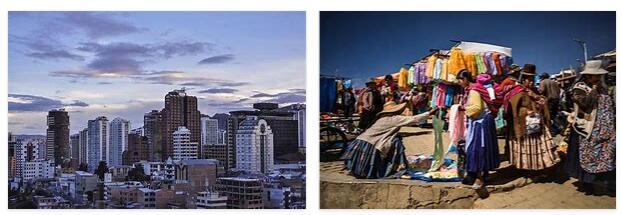Bolivia’s treasures: natural gas, soybeans – and coca
Natural gas is Bolivia’s most important natural resource today. Half of all export profits come from natural gas sales, mainly to Argentina and Brazil. Falling gas prices then quickly have a bad effect on the economy. The natural gas industry was nationalized in 2006.
Overall, Bolivia’s economy is growing. But there are also problems. Foreign companies are unwilling to set up companies in Bolivia, for example in mining.
There are close economic ties with Venezuela and Cuba, which for example buy large quantities of the soybeans produced in Bolivia. In 2006 the three countries founded the “Trade Treaty of the Peoples”. Support in technology and education was also agreed. They do not impose any duties on each other.
Agriculture
Almost 30 percent of Bolivians work in agriculture. But it only accounts for 13.8 percent of the country’s economic output. Soybeans, quinoa, sugar cane, coffee, cocoa, corn, rice, wheat and potatoes are grown. Bolivia produces the most Brazil nuts worldwide. The country ranks 10th for soybeans. They are Bolivia’s most important agricultural product – next to coca.
There are also large areas for coca bushes. Bolivia is the third largest producer of coca plants worldwide after Colombia and Peru – but also of cocaine, a dangerous drug. And of course that is against the law. In the 1980s, attempts were made to destroy land for coca and to offer farmers incentives to plant more coffee or citrus fruits. But that didn’t work out in the long run, because they simply earned more money with Coca.
In the highlands, many smallholders practice agriculture to support themselves. Only small yields are sold in the market. This is called subsistence farming. The counterpart to this are large plantations. For example, beans, cabbage, sweet potatoes, cassava, tomatoes and chickpeas are grown. Fruits are papaya, oranges, apples, cherries, figs, pineapples and bananas.
The Bolivians keep livestock, mainly cattle, but also chickens, pigs, goats and sheep. In addition, there are llamas, alpacas and vicunas in the highlands. They eat their meat and mainly process the wool from the alpacas.
Coca
Coca plants are traditionally grown in Bolivia. To get more information on Bolivia and America, check themotorcyclers. The leaves are chewed by the Indians or they make tea from them. This helps you avoid being cold and hungry. It also helps to overcome altitude sickness. You stay more awake. However, cocaine, a dangerous drug, can also be made from coca leaves. Incidentally, Coca-Cola no longer uses coca leaves, but until around 1929 they were a basic ingredient in the drink and gave it the first part of the name.
Industry
The industry generates 38 percent, although only 22 percent of Bolivians work here. Mining (especially for iron ore, zinc and tin) and the smelting of iron are important areas. Silver has lost its importance, but Bolivia is still the sixth largest producer in the world. However, gold, lead, antimony and tungsten (second largest producer in the world) are also mined.
It also processes foods such as soybeans, sugar cane and sunflower seeds. Metals are also processed and clothing is made.
A mineral resource that could bring huge profits would be lithium, which is stored under the Salar de Uyuni salt lake. It is the world’s largest deposit of this light metal. However, lithium production would destroy this unique natural landscape.
Services
The ratio only works with services: 48 percent work in this area and 48 percent are also earned. The services include trade, i.e. all types of shops, restaurants, banks, transport, energy (i.e. electricity) and also all tourism with hotels and travel providers. Tourism is growing, but overall it still plays a minor role. In 2018, around one million visitors came to Bolivia.
Lithium
Lithium is a light metal. You need it for batteries and accumulators. Lithium batteries and accumulators are mainly used in cell phones, cameras, tablets and notebooks.
